FINANCE 8: An Analysis of the Global Financial Crisis and Reforms
VerifiedAdded on 2022/06/01
|9
|2684
|42
Report
AI Summary
This report provides a comprehensive analysis of the 2008 Global Financial Crisis (GFC), exploring its background, major events, and underlying causes, including financial integration, monetary policy, and regulatory factors. It examines the scale and impact of the crisis on various economies, such as the USA, Europe, Australia, and developing nations like India, highlighting the effects on interbank markets, asset prices, employment, and capital flows. Furthermore, the report details the reforms undertaken by governments and regulatory bodies to address the crisis, including coordinated frameworks, international monetary system adjustments, and legislative measures like the Dodd-Frank Act. The report concludes with a discussion on the potential for reoccurrence of such crises, considering the current financial landscape, technological advancements, and ongoing regulations. The report uses sources like IMF, OECD and other financial publications to support the analysis.
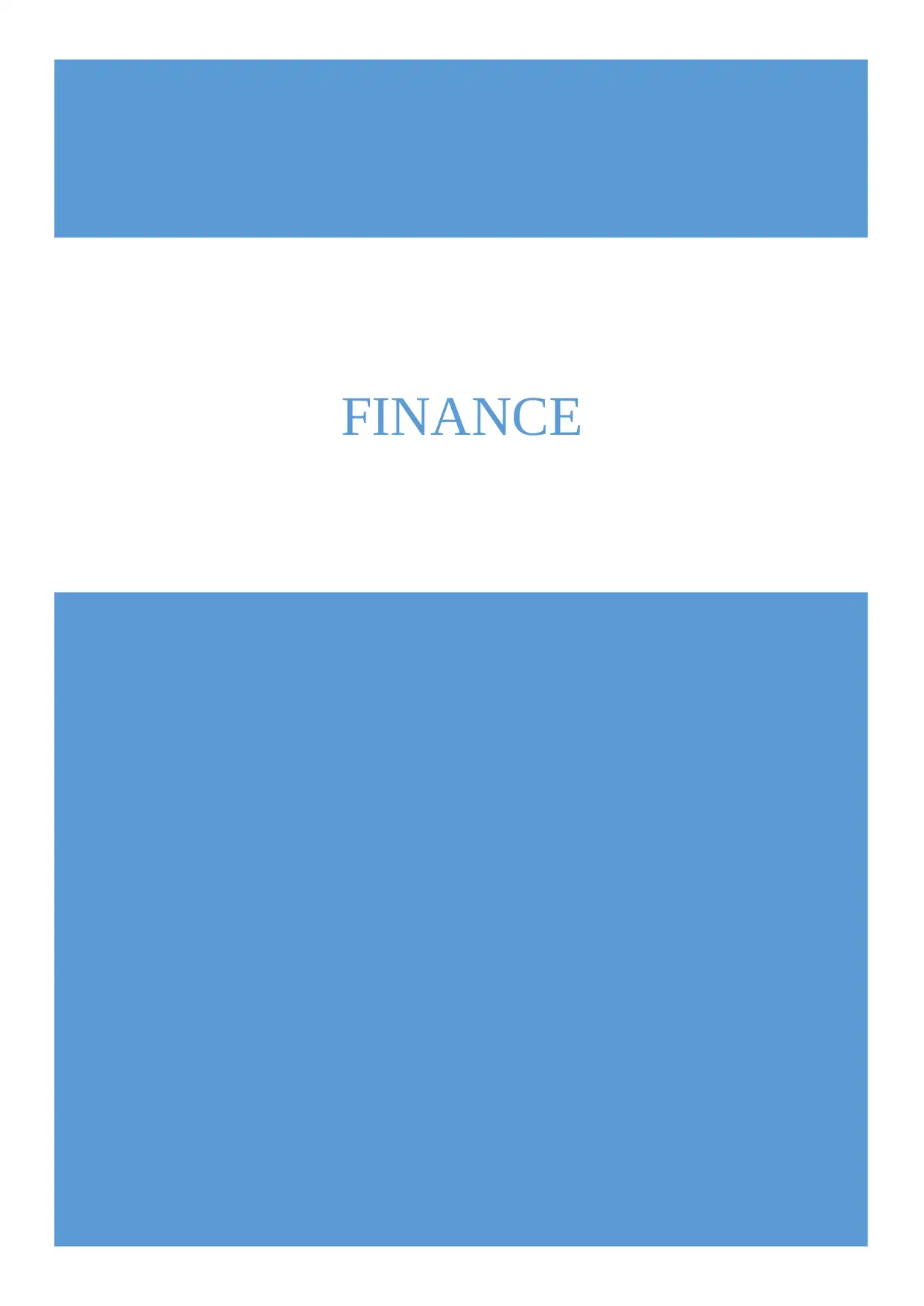
FINANCE
Paraphrase This Document
Need a fresh take? Get an instant paraphrase of this document with our AI Paraphraser
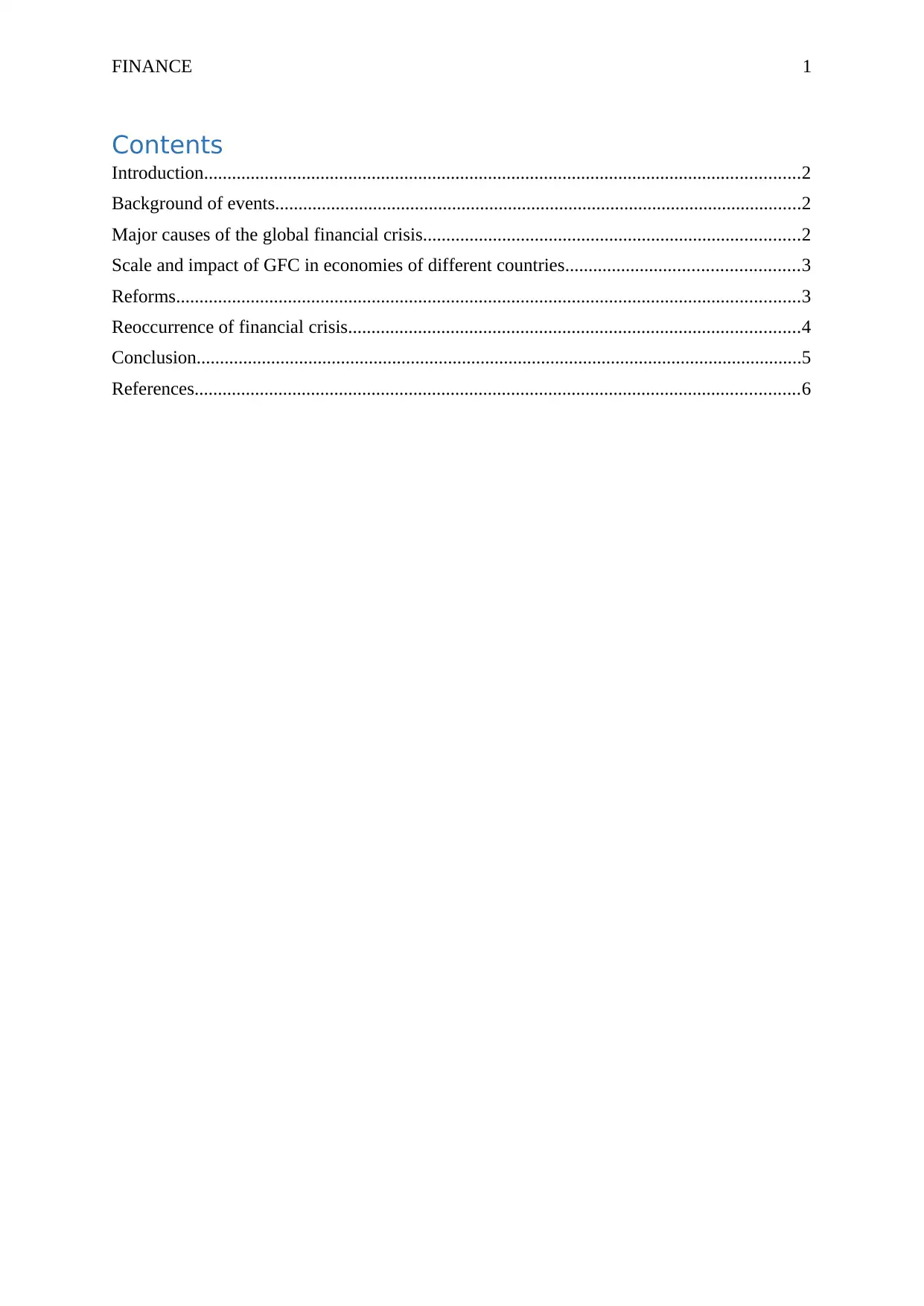
FINANCE 1
Contents
Introduction................................................................................................................................2
Background of events.................................................................................................................2
Major causes of the global financial crisis.................................................................................2
Scale and impact of GFC in economies of different countries..................................................3
Reforms......................................................................................................................................3
Reoccurrence of financial crisis.................................................................................................4
Conclusion..................................................................................................................................5
References..................................................................................................................................6
Contents
Introduction................................................................................................................................2
Background of events.................................................................................................................2
Major causes of the global financial crisis.................................................................................2
Scale and impact of GFC in economies of different countries..................................................3
Reforms......................................................................................................................................3
Reoccurrence of financial crisis.................................................................................................4
Conclusion..................................................................................................................................5
References..................................................................................................................................6
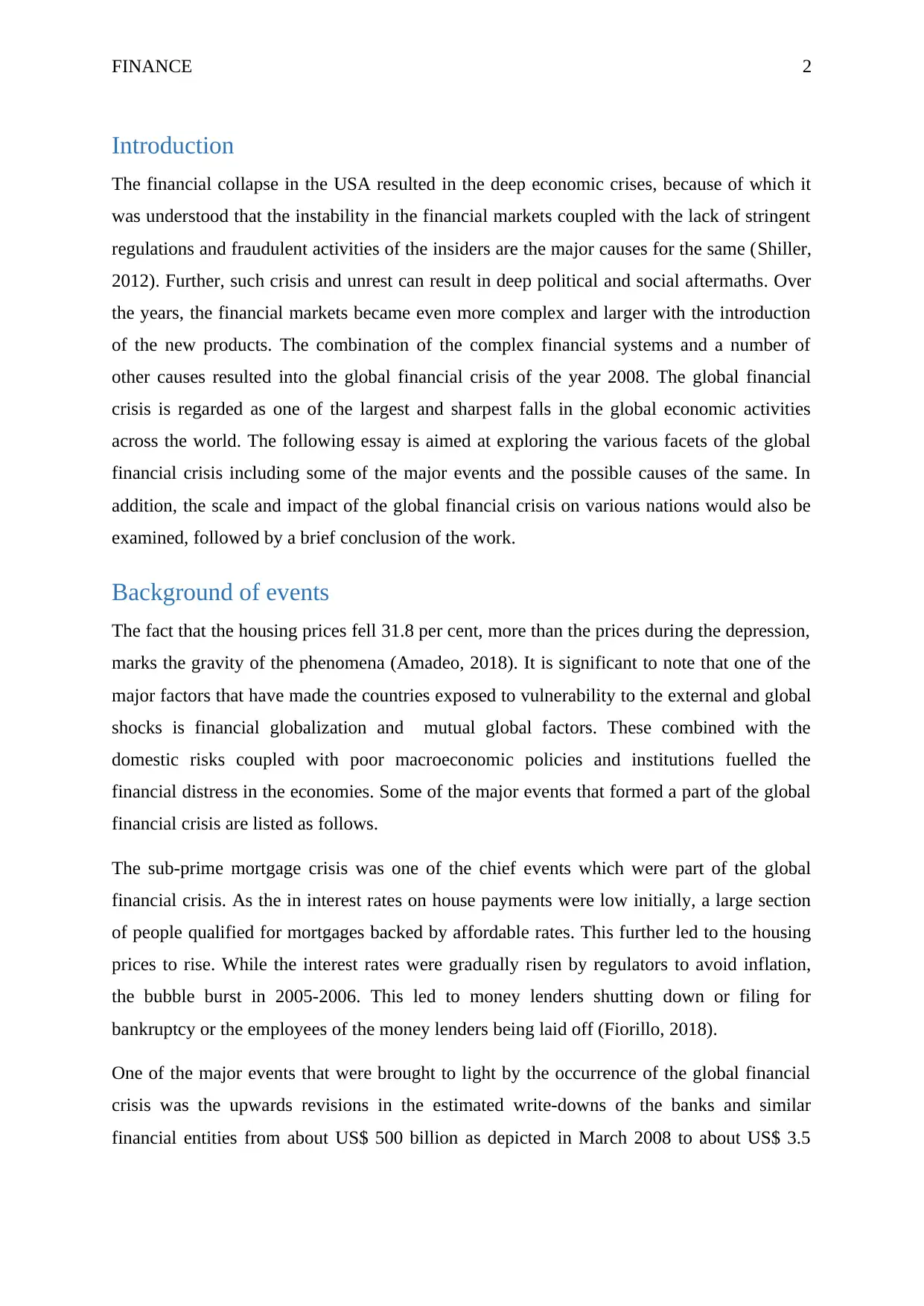
FINANCE 2
Introduction
The financial collapse in the USA resulted in the deep economic crises, because of which it
was understood that the instability in the financial markets coupled with the lack of stringent
regulations and fraudulent activities of the insiders are the major causes for the same (Shiller,
2012). Further, such crisis and unrest can result in deep political and social aftermaths. Over
the years, the financial markets became even more complex and larger with the introduction
of the new products. The combination of the complex financial systems and a number of
other causes resulted into the global financial crisis of the year 2008. The global financial
crisis is regarded as one of the largest and sharpest falls in the global economic activities
across the world. The following essay is aimed at exploring the various facets of the global
financial crisis including some of the major events and the possible causes of the same. In
addition, the scale and impact of the global financial crisis on various nations would also be
examined, followed by a brief conclusion of the work.
Background of events
The fact that the housing prices fell 31.8 per cent, more than the prices during the depression,
marks the gravity of the phenomena (Amadeo, 2018). It is significant to note that one of the
major factors that have made the countries exposed to vulnerability to the external and global
shocks is financial globalization and mutual global factors. These combined with the
domestic risks coupled with poor macroeconomic policies and institutions fuelled the
financial distress in the economies. Some of the major events that formed a part of the global
financial crisis are listed as follows.
The sub-prime mortgage crisis was one of the chief events which were part of the global
financial crisis. As the in interest rates on house payments were low initially, a large section
of people qualified for mortgages backed by affordable rates. This further led to the housing
prices to rise. While the interest rates were gradually risen by regulators to avoid inflation,
the bubble burst in 2005-2006. This led to money lenders shutting down or filing for
bankruptcy or the employees of the money lenders being laid off (Fiorillo, 2018).
One of the major events that were brought to light by the occurrence of the global financial
crisis was the upwards revisions in the estimated write-downs of the banks and similar
financial entities from about US$ 500 billion as depicted in March 2008 to about US$ 3.5
Introduction
The financial collapse in the USA resulted in the deep economic crises, because of which it
was understood that the instability in the financial markets coupled with the lack of stringent
regulations and fraudulent activities of the insiders are the major causes for the same (Shiller,
2012). Further, such crisis and unrest can result in deep political and social aftermaths. Over
the years, the financial markets became even more complex and larger with the introduction
of the new products. The combination of the complex financial systems and a number of
other causes resulted into the global financial crisis of the year 2008. The global financial
crisis is regarded as one of the largest and sharpest falls in the global economic activities
across the world. The following essay is aimed at exploring the various facets of the global
financial crisis including some of the major events and the possible causes of the same. In
addition, the scale and impact of the global financial crisis on various nations would also be
examined, followed by a brief conclusion of the work.
Background of events
The fact that the housing prices fell 31.8 per cent, more than the prices during the depression,
marks the gravity of the phenomena (Amadeo, 2018). It is significant to note that one of the
major factors that have made the countries exposed to vulnerability to the external and global
shocks is financial globalization and mutual global factors. These combined with the
domestic risks coupled with poor macroeconomic policies and institutions fuelled the
financial distress in the economies. Some of the major events that formed a part of the global
financial crisis are listed as follows.
The sub-prime mortgage crisis was one of the chief events which were part of the global
financial crisis. As the in interest rates on house payments were low initially, a large section
of people qualified for mortgages backed by affordable rates. This further led to the housing
prices to rise. While the interest rates were gradually risen by regulators to avoid inflation,
the bubble burst in 2005-2006. This led to money lenders shutting down or filing for
bankruptcy or the employees of the money lenders being laid off (Fiorillo, 2018).
One of the major events that were brought to light by the occurrence of the global financial
crisis was the upwards revisions in the estimated write-downs of the banks and similar
financial entities from about US$ 500 billion as depicted in March 2008 to about US$ 3.5
⊘ This is a preview!⊘
Do you want full access?
Subscribe today to unlock all pages.

Trusted by 1+ million students worldwide
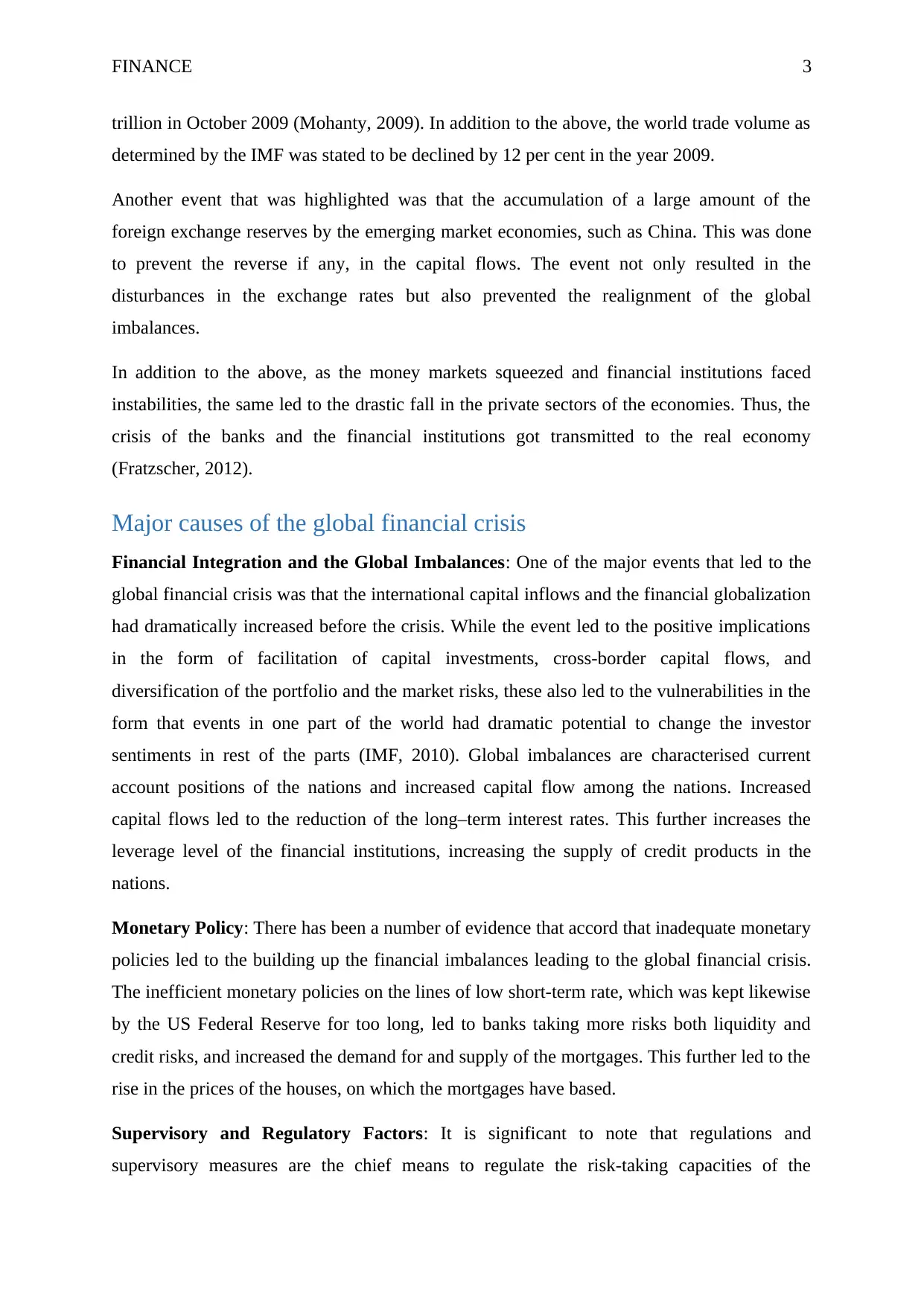
FINANCE 3
trillion in October 2009 (Mohanty, 2009). In addition to the above, the world trade volume as
determined by the IMF was stated to be declined by 12 per cent in the year 2009.
Another event that was highlighted was that the accumulation of a large amount of the
foreign exchange reserves by the emerging market economies, such as China. This was done
to prevent the reverse if any, in the capital flows. The event not only resulted in the
disturbances in the exchange rates but also prevented the realignment of the global
imbalances.
In addition to the above, as the money markets squeezed and financial institutions faced
instabilities, the same led to the drastic fall in the private sectors of the economies. Thus, the
crisis of the banks and the financial institutions got transmitted to the real economy
(Fratzscher, 2012).
Major causes of the global financial crisis
Financial Integration and the Global Imbalances: One of the major events that led to the
global financial crisis was that the international capital inflows and the financial globalization
had dramatically increased before the crisis. While the event led to the positive implications
in the form of facilitation of capital investments, cross-border capital flows, and
diversification of the portfolio and the market risks, these also led to the vulnerabilities in the
form that events in one part of the world had dramatic potential to change the investor
sentiments in rest of the parts (IMF, 2010). Global imbalances are characterised current
account positions of the nations and increased capital flow among the nations. Increased
capital flows led to the reduction of the long–term interest rates. This further increases the
leverage level of the financial institutions, increasing the supply of credit products in the
nations.
Monetary Policy: There has been a number of evidence that accord that inadequate monetary
policies led to the building up the financial imbalances leading to the global financial crisis.
The inefficient monetary policies on the lines of low short-term rate, which was kept likewise
by the US Federal Reserve for too long, led to banks taking more risks both liquidity and
credit risks, and increased the demand for and supply of the mortgages. This further led to the
rise in the prices of the houses, on which the mortgages have based.
Supervisory and Regulatory Factors: It is significant to note that regulations and
supervisory measures are the chief means to regulate the risk-taking capacities of the
trillion in October 2009 (Mohanty, 2009). In addition to the above, the world trade volume as
determined by the IMF was stated to be declined by 12 per cent in the year 2009.
Another event that was highlighted was that the accumulation of a large amount of the
foreign exchange reserves by the emerging market economies, such as China. This was done
to prevent the reverse if any, in the capital flows. The event not only resulted in the
disturbances in the exchange rates but also prevented the realignment of the global
imbalances.
In addition to the above, as the money markets squeezed and financial institutions faced
instabilities, the same led to the drastic fall in the private sectors of the economies. Thus, the
crisis of the banks and the financial institutions got transmitted to the real economy
(Fratzscher, 2012).
Major causes of the global financial crisis
Financial Integration and the Global Imbalances: One of the major events that led to the
global financial crisis was that the international capital inflows and the financial globalization
had dramatically increased before the crisis. While the event led to the positive implications
in the form of facilitation of capital investments, cross-border capital flows, and
diversification of the portfolio and the market risks, these also led to the vulnerabilities in the
form that events in one part of the world had dramatic potential to change the investor
sentiments in rest of the parts (IMF, 2010). Global imbalances are characterised current
account positions of the nations and increased capital flow among the nations. Increased
capital flows led to the reduction of the long–term interest rates. This further increases the
leverage level of the financial institutions, increasing the supply of credit products in the
nations.
Monetary Policy: There has been a number of evidence that accord that inadequate monetary
policies led to the building up the financial imbalances leading to the global financial crisis.
The inefficient monetary policies on the lines of low short-term rate, which was kept likewise
by the US Federal Reserve for too long, led to banks taking more risks both liquidity and
credit risks, and increased the demand for and supply of the mortgages. This further led to the
rise in the prices of the houses, on which the mortgages have based.
Supervisory and Regulatory Factors: It is significant to note that regulations and
supervisory measures are the chief means to regulate the risk-taking capacities of the
Paraphrase This Document
Need a fresh take? Get an instant paraphrase of this document with our AI Paraphraser
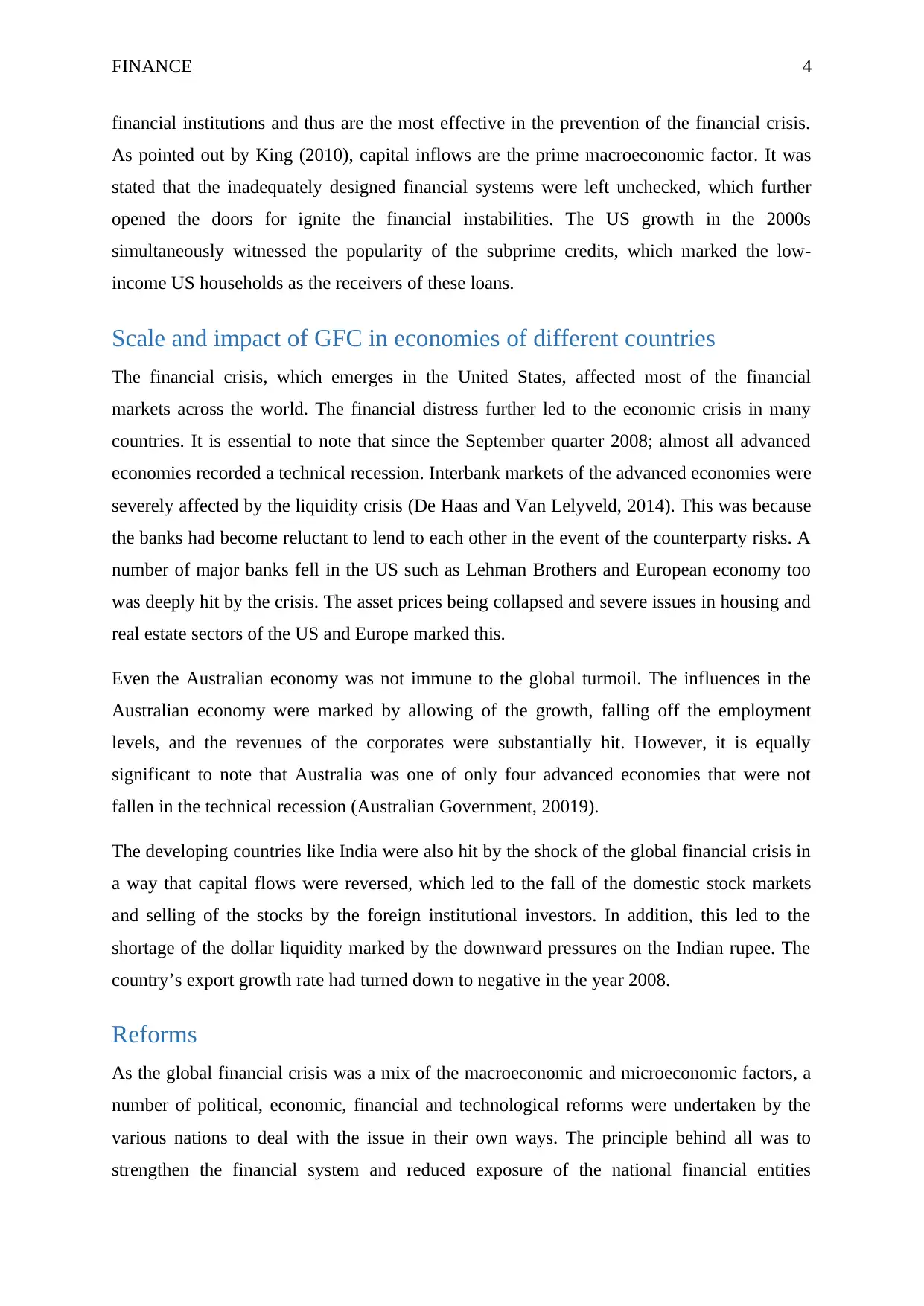
FINANCE 4
financial institutions and thus are the most effective in the prevention of the financial crisis.
As pointed out by King (2010), capital inflows are the prime macroeconomic factor. It was
stated that the inadequately designed financial systems were left unchecked, which further
opened the doors for ignite the financial instabilities. The US growth in the 2000s
simultaneously witnessed the popularity of the subprime credits, which marked the low-
income US households as the receivers of these loans.
Scale and impact of GFC in economies of different countries
The financial crisis, which emerges in the United States, affected most of the financial
markets across the world. The financial distress further led to the economic crisis in many
countries. It is essential to note that since the September quarter 2008; almost all advanced
economies recorded a technical recession. Interbank markets of the advanced economies were
severely affected by the liquidity crisis (De Haas and Van Lelyveld, 2014). This was because
the banks had become reluctant to lend to each other in the event of the counterparty risks. A
number of major banks fell in the US such as Lehman Brothers and European economy too
was deeply hit by the crisis. The asset prices being collapsed and severe issues in housing and
real estate sectors of the US and Europe marked this.
Even the Australian economy was not immune to the global turmoil. The influences in the
Australian economy were marked by allowing of the growth, falling off the employment
levels, and the revenues of the corporates were substantially hit. However, it is equally
significant to note that Australia was one of only four advanced economies that were not
fallen in the technical recession (Australian Government, 20019).
The developing countries like India were also hit by the shock of the global financial crisis in
a way that capital flows were reversed, which led to the fall of the domestic stock markets
and selling of the stocks by the foreign institutional investors. In addition, this led to the
shortage of the dollar liquidity marked by the downward pressures on the Indian rupee. The
country’s export growth rate had turned down to negative in the year 2008.
Reforms
As the global financial crisis was a mix of the macroeconomic and microeconomic factors, a
number of political, economic, financial and technological reforms were undertaken by the
various nations to deal with the issue in their own ways. The principle behind all was to
strengthen the financial system and reduced exposure of the national financial entities
financial institutions and thus are the most effective in the prevention of the financial crisis.
As pointed out by King (2010), capital inflows are the prime macroeconomic factor. It was
stated that the inadequately designed financial systems were left unchecked, which further
opened the doors for ignite the financial instabilities. The US growth in the 2000s
simultaneously witnessed the popularity of the subprime credits, which marked the low-
income US households as the receivers of these loans.
Scale and impact of GFC in economies of different countries
The financial crisis, which emerges in the United States, affected most of the financial
markets across the world. The financial distress further led to the economic crisis in many
countries. It is essential to note that since the September quarter 2008; almost all advanced
economies recorded a technical recession. Interbank markets of the advanced economies were
severely affected by the liquidity crisis (De Haas and Van Lelyveld, 2014). This was because
the banks had become reluctant to lend to each other in the event of the counterparty risks. A
number of major banks fell in the US such as Lehman Brothers and European economy too
was deeply hit by the crisis. The asset prices being collapsed and severe issues in housing and
real estate sectors of the US and Europe marked this.
Even the Australian economy was not immune to the global turmoil. The influences in the
Australian economy were marked by allowing of the growth, falling off the employment
levels, and the revenues of the corporates were substantially hit. However, it is equally
significant to note that Australia was one of only four advanced economies that were not
fallen in the technical recession (Australian Government, 20019).
The developing countries like India were also hit by the shock of the global financial crisis in
a way that capital flows were reversed, which led to the fall of the domestic stock markets
and selling of the stocks by the foreign institutional investors. In addition, this led to the
shortage of the dollar liquidity marked by the downward pressures on the Indian rupee. The
country’s export growth rate had turned down to negative in the year 2008.
Reforms
As the global financial crisis was a mix of the macroeconomic and microeconomic factors, a
number of political, economic, financial and technological reforms were undertaken by the
various nations to deal with the issue in their own ways. The principle behind all was to
strengthen the financial system and reduced exposure of the national financial entities
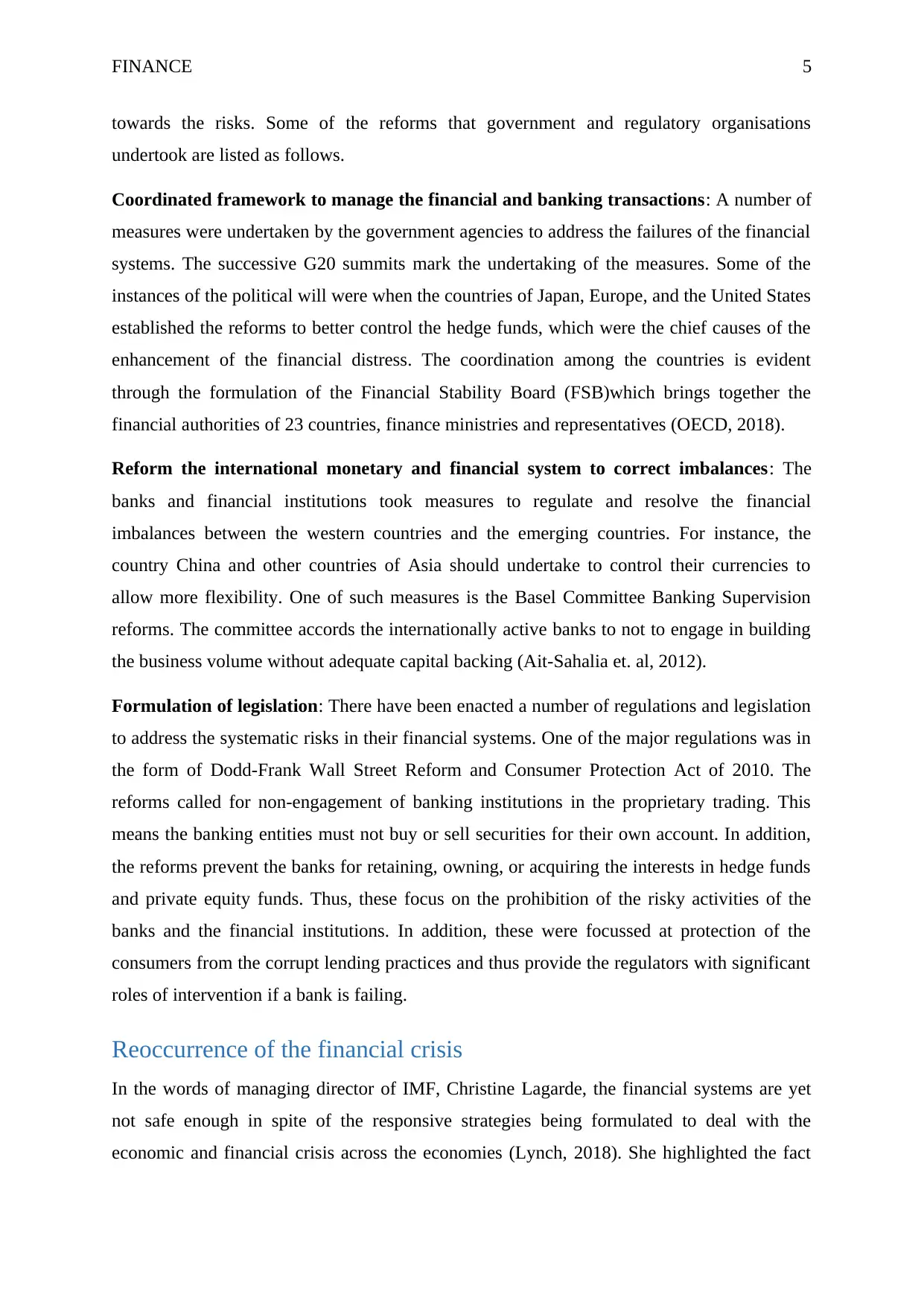
FINANCE 5
towards the risks. Some of the reforms that government and regulatory organisations
undertook are listed as follows.
Coordinated framework to manage the financial and banking transactions: A number of
measures were undertaken by the government agencies to address the failures of the financial
systems. The successive G20 summits mark the undertaking of the measures. Some of the
instances of the political will were when the countries of Japan, Europe, and the United States
established the reforms to better control the hedge funds, which were the chief causes of the
enhancement of the financial distress. The coordination among the countries is evident
through the formulation of the Financial Stability Board (FSB)which brings together the
financial authorities of 23 countries, finance ministries and representatives (OECD, 2018).
Reform the international monetary and financial system to correct imbalances: The
banks and financial institutions took measures to regulate and resolve the financial
imbalances between the western countries and the emerging countries. For instance, the
country China and other countries of Asia should undertake to control their currencies to
allow more flexibility. One of such measures is the Basel Committee Banking Supervision
reforms. The committee accords the internationally active banks to not to engage in building
the business volume without adequate capital backing (Ait-Sahalia et. al, 2012).
Formulation of legislation: There have been enacted a number of regulations and legislation
to address the systematic risks in their financial systems. One of the major regulations was in
the form of Dodd-Frank Wall Street Reform and Consumer Protection Act of 2010. The
reforms called for non-engagement of banking institutions in the proprietary trading. This
means the banking entities must not buy or sell securities for their own account. In addition,
the reforms prevent the banks for retaining, owning, or acquiring the interests in hedge funds
and private equity funds. Thus, these focus on the prohibition of the risky activities of the
banks and the financial institutions. In addition, these were focussed at protection of the
consumers from the corrupt lending practices and thus provide the regulators with significant
roles of intervention if a bank is failing.
Reoccurrence of the financial crisis
In the words of managing director of IMF, Christine Lagarde, the financial systems are yet
not safe enough in spite of the responsive strategies being formulated to deal with the
economic and financial crisis across the economies (Lynch, 2018). She highlighted the fact
towards the risks. Some of the reforms that government and regulatory organisations
undertook are listed as follows.
Coordinated framework to manage the financial and banking transactions: A number of
measures were undertaken by the government agencies to address the failures of the financial
systems. The successive G20 summits mark the undertaking of the measures. Some of the
instances of the political will were when the countries of Japan, Europe, and the United States
established the reforms to better control the hedge funds, which were the chief causes of the
enhancement of the financial distress. The coordination among the countries is evident
through the formulation of the Financial Stability Board (FSB)which brings together the
financial authorities of 23 countries, finance ministries and representatives (OECD, 2018).
Reform the international monetary and financial system to correct imbalances: The
banks and financial institutions took measures to regulate and resolve the financial
imbalances between the western countries and the emerging countries. For instance, the
country China and other countries of Asia should undertake to control their currencies to
allow more flexibility. One of such measures is the Basel Committee Banking Supervision
reforms. The committee accords the internationally active banks to not to engage in building
the business volume without adequate capital backing (Ait-Sahalia et. al, 2012).
Formulation of legislation: There have been enacted a number of regulations and legislation
to address the systematic risks in their financial systems. One of the major regulations was in
the form of Dodd-Frank Wall Street Reform and Consumer Protection Act of 2010. The
reforms called for non-engagement of banking institutions in the proprietary trading. This
means the banking entities must not buy or sell securities for their own account. In addition,
the reforms prevent the banks for retaining, owning, or acquiring the interests in hedge funds
and private equity funds. Thus, these focus on the prohibition of the risky activities of the
banks and the financial institutions. In addition, these were focussed at protection of the
consumers from the corrupt lending practices and thus provide the regulators with significant
roles of intervention if a bank is failing.
Reoccurrence of the financial crisis
In the words of managing director of IMF, Christine Lagarde, the financial systems are yet
not safe enough in spite of the responsive strategies being formulated to deal with the
economic and financial crisis across the economies (Lynch, 2018). She highlighted the fact
⊘ This is a preview!⊘
Do you want full access?
Subscribe today to unlock all pages.

Trusted by 1+ million students worldwide
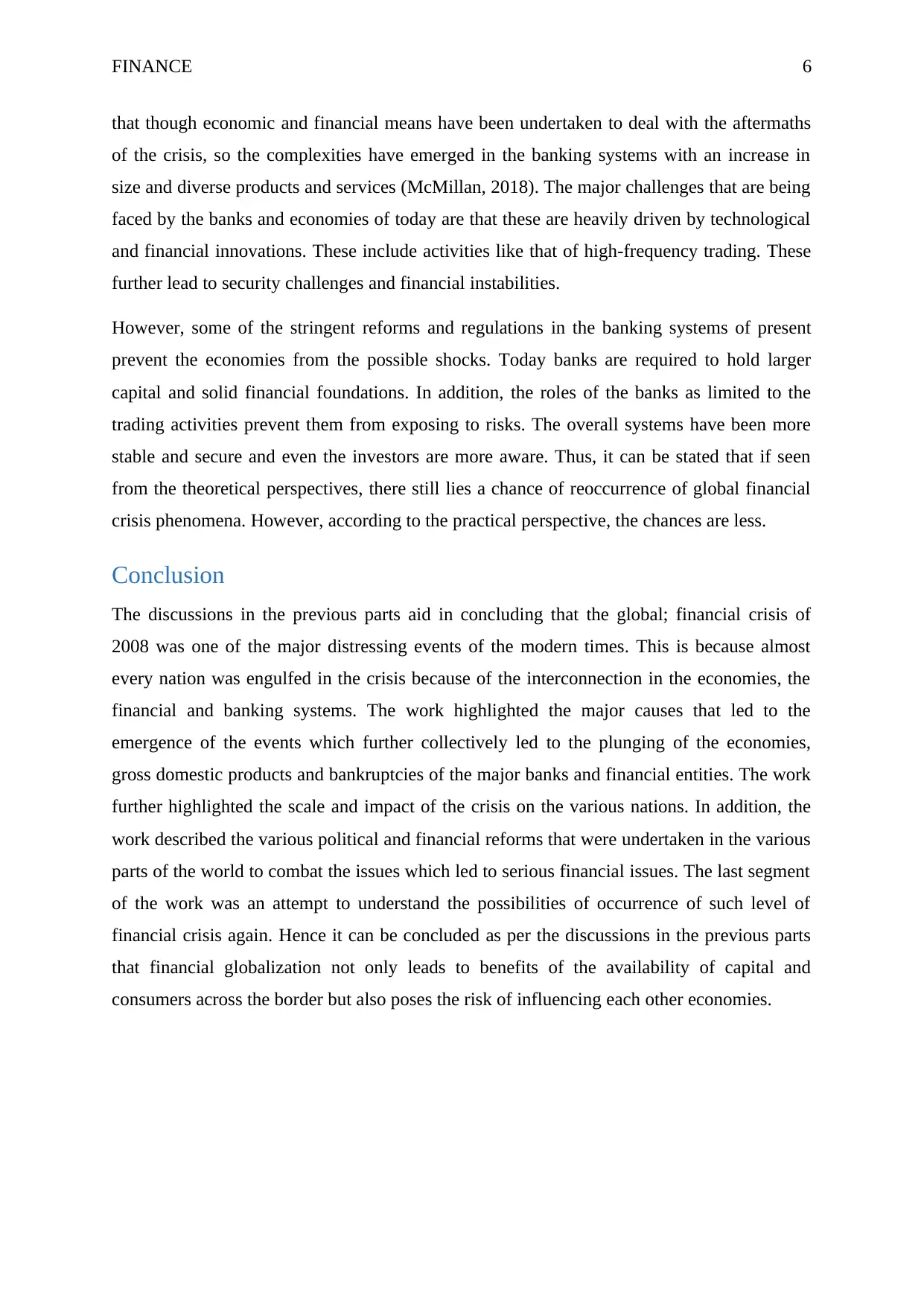
FINANCE 6
that though economic and financial means have been undertaken to deal with the aftermaths
of the crisis, so the complexities have emerged in the banking systems with an increase in
size and diverse products and services (McMillan, 2018). The major challenges that are being
faced by the banks and economies of today are that these are heavily driven by technological
and financial innovations. These include activities like that of high-frequency trading. These
further lead to security challenges and financial instabilities.
However, some of the stringent reforms and regulations in the banking systems of present
prevent the economies from the possible shocks. Today banks are required to hold larger
capital and solid financial foundations. In addition, the roles of the banks as limited to the
trading activities prevent them from exposing to risks. The overall systems have been more
stable and secure and even the investors are more aware. Thus, it can be stated that if seen
from the theoretical perspectives, there still lies a chance of reoccurrence of global financial
crisis phenomena. However, according to the practical perspective, the chances are less.
Conclusion
The discussions in the previous parts aid in concluding that the global; financial crisis of
2008 was one of the major distressing events of the modern times. This is because almost
every nation was engulfed in the crisis because of the interconnection in the economies, the
financial and banking systems. The work highlighted the major causes that led to the
emergence of the events which further collectively led to the plunging of the economies,
gross domestic products and bankruptcies of the major banks and financial entities. The work
further highlighted the scale and impact of the crisis on the various nations. In addition, the
work described the various political and financial reforms that were undertaken in the various
parts of the world to combat the issues which led to serious financial issues. The last segment
of the work was an attempt to understand the possibilities of occurrence of such level of
financial crisis again. Hence it can be concluded as per the discussions in the previous parts
that financial globalization not only leads to benefits of the availability of capital and
consumers across the border but also poses the risk of influencing each other economies.
that though economic and financial means have been undertaken to deal with the aftermaths
of the crisis, so the complexities have emerged in the banking systems with an increase in
size and diverse products and services (McMillan, 2018). The major challenges that are being
faced by the banks and economies of today are that these are heavily driven by technological
and financial innovations. These include activities like that of high-frequency trading. These
further lead to security challenges and financial instabilities.
However, some of the stringent reforms and regulations in the banking systems of present
prevent the economies from the possible shocks. Today banks are required to hold larger
capital and solid financial foundations. In addition, the roles of the banks as limited to the
trading activities prevent them from exposing to risks. The overall systems have been more
stable and secure and even the investors are more aware. Thus, it can be stated that if seen
from the theoretical perspectives, there still lies a chance of reoccurrence of global financial
crisis phenomena. However, according to the practical perspective, the chances are less.
Conclusion
The discussions in the previous parts aid in concluding that the global; financial crisis of
2008 was one of the major distressing events of the modern times. This is because almost
every nation was engulfed in the crisis because of the interconnection in the economies, the
financial and banking systems. The work highlighted the major causes that led to the
emergence of the events which further collectively led to the plunging of the economies,
gross domestic products and bankruptcies of the major banks and financial entities. The work
further highlighted the scale and impact of the crisis on the various nations. In addition, the
work described the various political and financial reforms that were undertaken in the various
parts of the world to combat the issues which led to serious financial issues. The last segment
of the work was an attempt to understand the possibilities of occurrence of such level of
financial crisis again. Hence it can be concluded as per the discussions in the previous parts
that financial globalization not only leads to benefits of the availability of capital and
consumers across the border but also poses the risk of influencing each other economies.
Paraphrase This Document
Need a fresh take? Get an instant paraphrase of this document with our AI Paraphraser
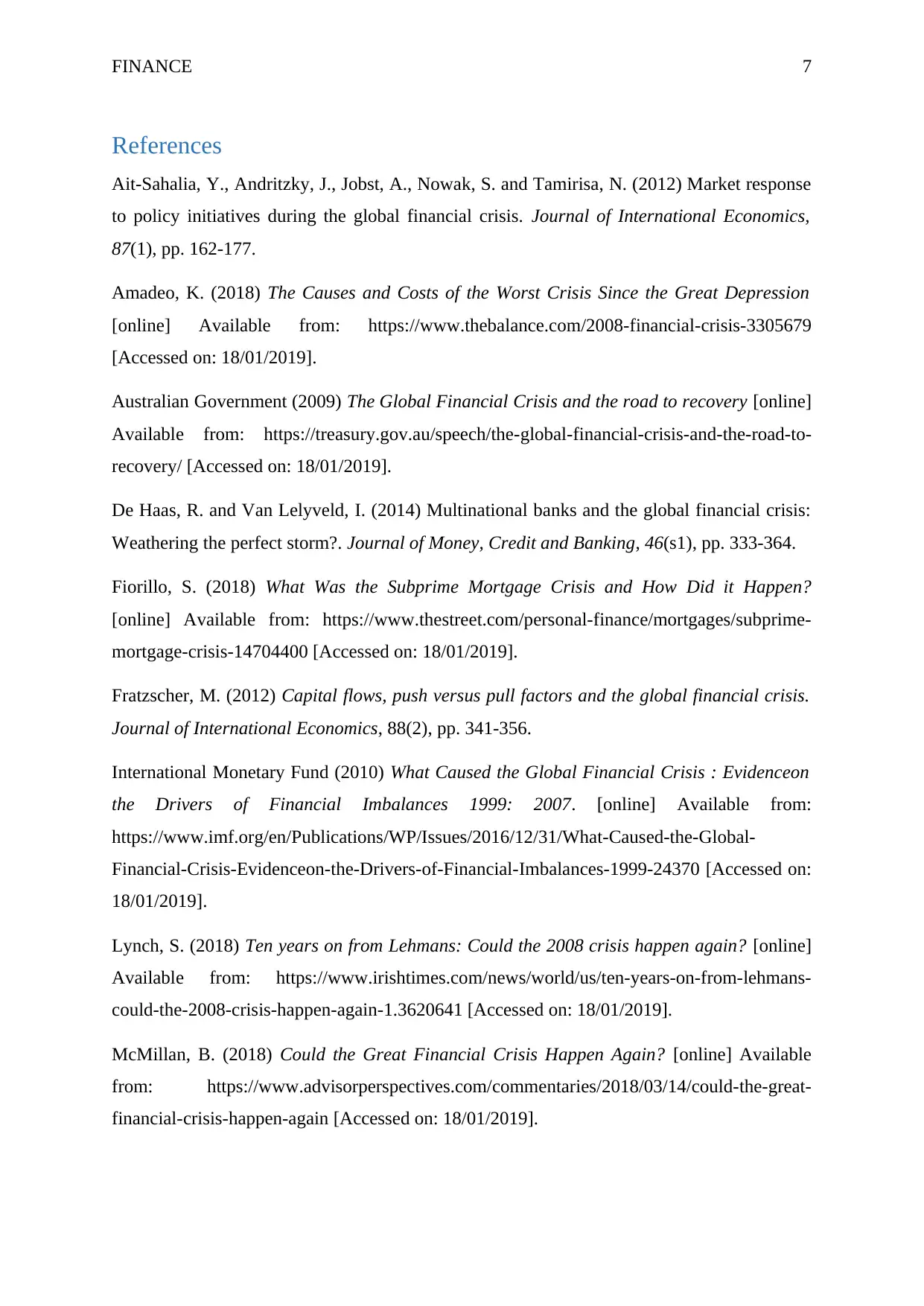
FINANCE 7
References
Ait-Sahalia, Y., Andritzky, J., Jobst, A., Nowak, S. and Tamirisa, N. (2012) Market response
to policy initiatives during the global financial crisis. Journal of International Economics,
87(1), pp. 162-177.
Amadeo, K. (2018) The Causes and Costs of the Worst Crisis Since the Great Depression
[online] Available from: https://www.thebalance.com/2008-financial-crisis-3305679
[Accessed on: 18/01/2019].
Australian Government (2009) The Global Financial Crisis and the road to recovery [online]
Available from: https://treasury.gov.au/speech/the-global-financial-crisis-and-the-road-to-
recovery/ [Accessed on: 18/01/2019].
De Haas, R. and Van Lelyveld, I. (2014) Multinational banks and the global financial crisis:
Weathering the perfect storm?. Journal of Money, Credit and Banking, 46(s1), pp. 333-364.
Fiorillo, S. (2018) What Was the Subprime Mortgage Crisis and How Did it Happen?
[online] Available from: https://www.thestreet.com/personal-finance/mortgages/subprime-
mortgage-crisis-14704400 [Accessed on: 18/01/2019].
Fratzscher, M. (2012) Capital flows, push versus pull factors and the global financial crisis.
Journal of International Economics, 88(2), pp. 341-356.
International Monetary Fund (2010) What Caused the Global Financial Crisis : Evidenceon
the Drivers of Financial Imbalances 1999: 2007. [online] Available from:
https://www.imf.org/en/Publications/WP/Issues/2016/12/31/What-Caused-the-Global-
Financial-Crisis-Evidenceon-the-Drivers-of-Financial-Imbalances-1999-24370 [Accessed on:
18/01/2019].
Lynch, S. (2018) Ten years on from Lehmans: Could the 2008 crisis happen again? [online]
Available from: https://www.irishtimes.com/news/world/us/ten-years-on-from-lehmans-
could-the-2008-crisis-happen-again-1.3620641 [Accessed on: 18/01/2019].
McMillan, B. (2018) Could the Great Financial Crisis Happen Again? [online] Available
from: https://www.advisorperspectives.com/commentaries/2018/03/14/could-the-great-
financial-crisis-happen-again [Accessed on: 18/01/2019].
References
Ait-Sahalia, Y., Andritzky, J., Jobst, A., Nowak, S. and Tamirisa, N. (2012) Market response
to policy initiatives during the global financial crisis. Journal of International Economics,
87(1), pp. 162-177.
Amadeo, K. (2018) The Causes and Costs of the Worst Crisis Since the Great Depression
[online] Available from: https://www.thebalance.com/2008-financial-crisis-3305679
[Accessed on: 18/01/2019].
Australian Government (2009) The Global Financial Crisis and the road to recovery [online]
Available from: https://treasury.gov.au/speech/the-global-financial-crisis-and-the-road-to-
recovery/ [Accessed on: 18/01/2019].
De Haas, R. and Van Lelyveld, I. (2014) Multinational banks and the global financial crisis:
Weathering the perfect storm?. Journal of Money, Credit and Banking, 46(s1), pp. 333-364.
Fiorillo, S. (2018) What Was the Subprime Mortgage Crisis and How Did it Happen?
[online] Available from: https://www.thestreet.com/personal-finance/mortgages/subprime-
mortgage-crisis-14704400 [Accessed on: 18/01/2019].
Fratzscher, M. (2012) Capital flows, push versus pull factors and the global financial crisis.
Journal of International Economics, 88(2), pp. 341-356.
International Monetary Fund (2010) What Caused the Global Financial Crisis : Evidenceon
the Drivers of Financial Imbalances 1999: 2007. [online] Available from:
https://www.imf.org/en/Publications/WP/Issues/2016/12/31/What-Caused-the-Global-
Financial-Crisis-Evidenceon-the-Drivers-of-Financial-Imbalances-1999-24370 [Accessed on:
18/01/2019].
Lynch, S. (2018) Ten years on from Lehmans: Could the 2008 crisis happen again? [online]
Available from: https://www.irishtimes.com/news/world/us/ten-years-on-from-lehmans-
could-the-2008-crisis-happen-again-1.3620641 [Accessed on: 18/01/2019].
McMillan, B. (2018) Could the Great Financial Crisis Happen Again? [online] Available
from: https://www.advisorperspectives.com/commentaries/2018/03/14/could-the-great-
financial-crisis-happen-again [Accessed on: 18/01/2019].
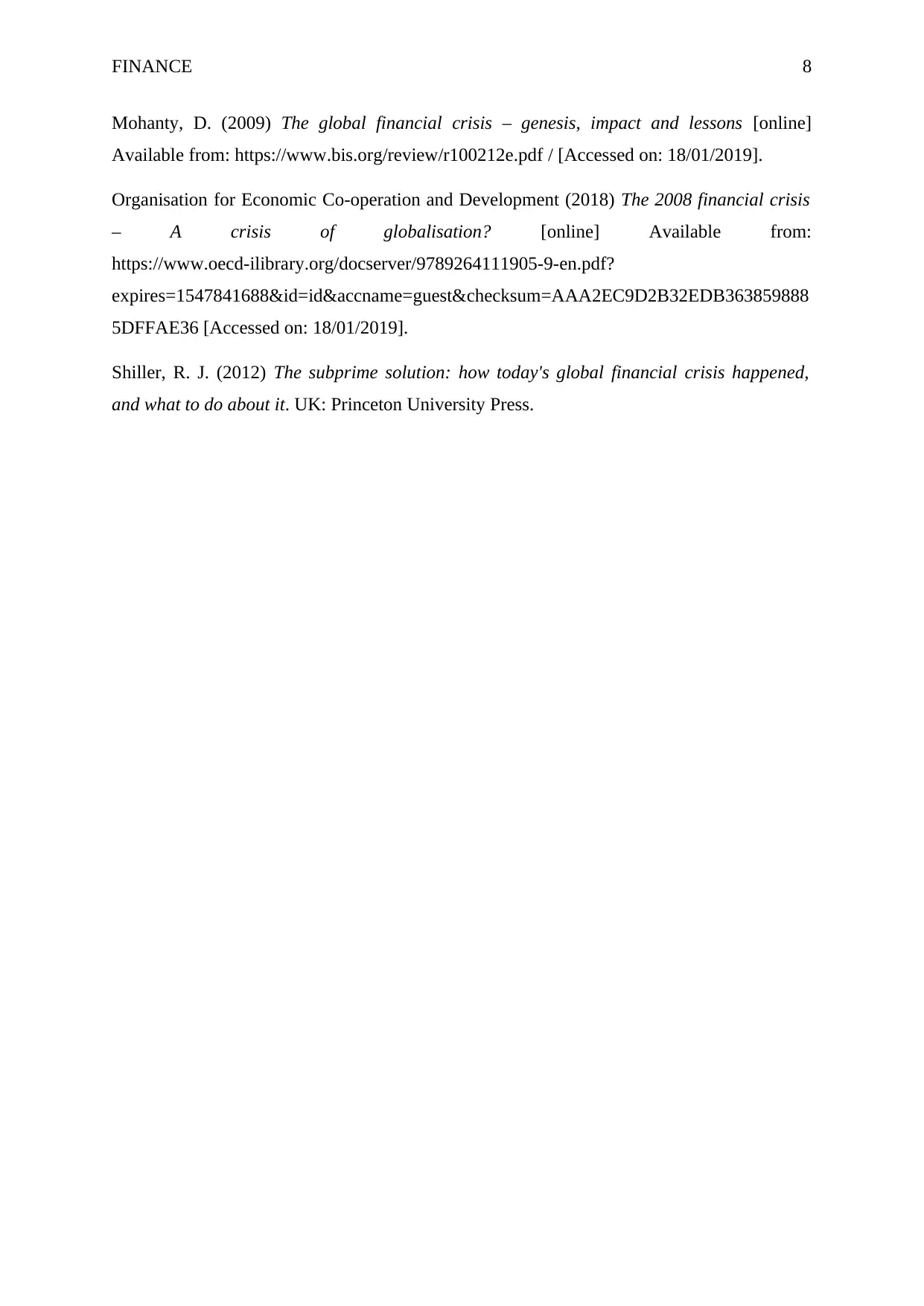
FINANCE 8
Mohanty, D. (2009) The global financial crisis – genesis, impact and lessons [online]
Available from: https://www.bis.org/review/r100212e.pdf / [Accessed on: 18/01/2019].
Organisation for Economic Co-operation and Development (2018) The 2008 financial crisis
– A crisis of globalisation? [online] Available from:
https://www.oecd-ilibrary.org/docserver/9789264111905-9-en.pdf?
expires=1547841688&id=id&accname=guest&checksum=AAA2EC9D2B32EDB363859888
5DFFAE36 [Accessed on: 18/01/2019].
Shiller, R. J. (2012) The subprime solution: how today's global financial crisis happened,
and what to do about it. UK: Princeton University Press.
Mohanty, D. (2009) The global financial crisis – genesis, impact and lessons [online]
Available from: https://www.bis.org/review/r100212e.pdf / [Accessed on: 18/01/2019].
Organisation for Economic Co-operation and Development (2018) The 2008 financial crisis
– A crisis of globalisation? [online] Available from:
https://www.oecd-ilibrary.org/docserver/9789264111905-9-en.pdf?
expires=1547841688&id=id&accname=guest&checksum=AAA2EC9D2B32EDB363859888
5DFFAE36 [Accessed on: 18/01/2019].
Shiller, R. J. (2012) The subprime solution: how today's global financial crisis happened,
and what to do about it. UK: Princeton University Press.
⊘ This is a preview!⊘
Do you want full access?
Subscribe today to unlock all pages.

Trusted by 1+ million students worldwide
1 out of 9
Related Documents
Your All-in-One AI-Powered Toolkit for Academic Success.
+13062052269
info@desklib.com
Available 24*7 on WhatsApp / Email
![[object Object]](/_next/static/media/star-bottom.7253800d.svg)
Unlock your academic potential
Copyright © 2020–2025 A2Z Services. All Rights Reserved. Developed and managed by ZUCOL.





